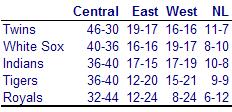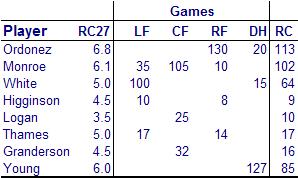Continuing on with my interview with Ernie Harwell. Click here for part one.
DTW: Since the format of the Veterans Committee was changed, there have been two elections, and nobody was elected. Do you think that?s appropriate, or do you think that the Committee will be changed again?
EH: Well, I think they might tweak it, but I think one of the strengths of the Baseball Hall of Fame is that it?s more difficult to get into than most other halls of fame in sports. And I?d like to keep it that way. I don?t think it?s really bad that you don?t elect anybody. But I also think that probably, in the long run, that the Veteran?s Committee is something that time has bypassed. I think most of the people that really belong in there, with a few exceptions, have been selected by the writers. I don?t like the idea of the second chance that is symbolized by the Veteran?s Committee. I know a lot of people disagree with that because there are some players that are on the cusp, on the margin there that I?d like to see in. But I like that it?s tough to get in.
DTW: My favorite player is Lou Whitaker, does he have a shot?
EH: I don?t think so. I think the voting that we?ve seen indicates that he wouldn?t have much of a chance. He?s very deserving if you look at the stats, and compare him with second basemen who are in there. He ranks right near the top I?d say, but there are a lot of things that factor in. One of them is exposure in the World Series. One of them is the media center in New York. I think a lot of things get factored in and he doesn?t have much of a chance.
DTW: So the same fate is probably true of his Tiger teammates like Trammell as well?
EH: Regretfully I have to say it does. His showing in the balloting just wasn?t strong enough to give us any optimism that he?ll get in.
DTW: Given the recent steroid allegations, if they came up on the VC ballot, would you vote for some of the guys who?ve been accused/suspected like Bonds and McGwire?
EH: I think I?d vote in favor of those two guys.
I really think the steroid situation will die down in a little while. It was brought to the attention of Congress and I think it?s a good that it?s out in the open. And I also felt that baseball could have avoided that if commissioner and players union had gotten together earlier and had nipped it in the bud, and issued a strong policy against steroids which they didn?t do. And they still haven?t done.
Although it was a great embarrassment to baseball, I think it?s good that it came out and maybe something will happen now to strengthen the ruling about using steroids.
The way I feel about records is that you have to take them as they come. I don?t believe anybody would be able to figure it out. Let?s take say Barry Bonds, and you were to make some asterisk to his home run total. I don?t know how you?d figure out when he started taking steroids, or if he did. It?s such a murky situation. I think we sort of have to just accept it, and as we talk about it just say ?well, he probably took steroids while he was playing.?
DTW: Does this just become another era like pre-segregation, WWII, the spitball era, the deadball era?
EH: Yeah, I think so. I think you?ve got to say back in 1909 guys were hitting less than 10 home runs and leading the league ?that was one era, just like you said. Then the spitball came in and went out and that was another era. Then you had the so-called lively ball coming in. Way back you had moving the pitching mound back to 60 feet, 6 inches. And you have more changes like that. You have smaller ball parks, bigger guys, and there are so many variations that come and go in baseball. I think this just has to be another one.
DTW: Speaking of eras, is there one you are most fond of, or would have like to have seen?
EH: I sort of would have liked to have been around during the dead ball era. I think that was pretty interesting. First the ballparks were primitive. The equipment wasn?t very good. But, maybe things were a little purer then, about the game than they are now. Though they had a lot of rascals, and a lot of things happened that they?d [laughing] put an evil eye on now. But from a standpoint of what we knew how people followed the game at that time, it was really more just a game. The only way people followed the games those days was through the newspapers. You didn?t have the investigation, and all the pressure and media attention that you have now that puts the spotlight on everything and digs in the dirt and brings out somethings we don?t want to know.
DTW: Over the years I know you?ve amassed a large collection of memorabilia and artifacts. Are there a couple that are most special to you?
EH: Well, I?ve gotten rid of most of them because I gave them to the library. The
Detroit Public Library has most of my stuff. And when we moved in 2003, I just couldn?t bring the stuff with me so we had an auction. An auction house in Chicago auctioned off what was left that I didn?t give to the library. So I really don?t have anything anymore. I had a Babe Ruth check at one time. I had my World Series rings, a replica of the 1968 World Series trophy. I had signed pictures from guys. I was proud of all those things, but you?ve got to move on.
DTW: To wrap things up, I?m going to ask you about some of your favorites
DTW: What was your favorite season to call?
EH: Well, I think that it is probably 1968 or 1984. They were pretty equal. 1968 a little bit more maybe because it followed the riots and it was a longer interim between championships between ?45 and ?68 than ?68 and ?84. So I think that one would probably be my favorite.
Ebbetts field in Brooklyn was really great for me because it was my first job, and I really liked the people. The Dodgers had a contending team, a pennant winner my second year there.
There?s so many things. You know the Giants won in ?51 and that was a great thrill. Just going to Baltimore and being the first announcer there was a great break for me as well.
So it?s hard to put your finger on, but I?d probably say it?s the ?68 Tigers.
DTW: Favorite manager?
EH: I?ve got a lot of them. The guy I like the best out of all the managers I worked with was probably Sparky. I think he was probably the best manager that I saw. I liked
Durocher, he was a good sharp one.
Bob Scheffing was one of my personal favorites. Although he didn?t last too long, we were real close friends.
Paul Richards was another one that I had a lot of admiration for. He taught me more about baseball than any of the other guys.
DTW: Favorite umpire?
EH: [laughing] I guess Nestor Shylack. I liked his attitude. I liked his enthusiasm. I liked the way he approached the game. I liked the way he was fairly liberal with not tossing guys out. And he was an excellent umpire. There were a lot of great ones, but I think probably he was my favorite.
DTW: Most interesting baseball character?
DTW: One of my favorite things about listening to you call games were the anecdotes that you?d sprinkle throughout the broadcast. What are a couple of your favorite baseball stories?
EH: Well you know, everybody has a different reaction I guess. One of them that I liked a lot was the rookie in the Southern League. Joe Engel was sort of the Barnum of Baseball in the minor leagues, sort of an early Bill Veeck. He had a shortstop that was holding out. In those days a telegram was a big deal. You negotiated by Western Union. He got a telegram from this guy who said ?Pay me $5000 or count me out.? So Joe Engel sent back a telegram that said, ?One, Two, Three, Four, Five, Six, Seven, Eight, Nine, Ten.?
Another one I like is Gene Mauch, when he retired as a player he actually got a hammer and nails and nailed his shoes up against his locker.
Those things, there?s millions of them and it is sort of hard to put your finger on one. I sort of like the one about the two-tone bat. It started when Dixie Walker went to Louisville and he found a bat in a bucket of paint. About half way up the bat was one color, and the rest of the way up the bat was another color. That started the two-tone bat.
But all those things I like to delve into them because they are a little bit different.
At this point we wrapped things up and I thanked Mr. Harwell profusely.
He was very generous with this tims, and very patient with me as I nervously stumbled through my questions. I grew up listening to Ernie, and the number of times that he and Paul Carey put me to bed at night were countless. I’d set my clock-radio to ‘Sleep’ and listen as long as I could stay awake. When I shared that with Ernie his response was simply, “we sure cured a lot of insomnia.”
The biggest thrill for me doing this interview was listening to Ernie talk about some of his favorite stories. Each story on its own isn’t that remarkable. However, it is all the small stories, like the ones he shared, that seperate baseball from the other sports. It’s the funny quotes and situations that can only be born in the midst of a summer long schedule. When the stories are combined they form the fabric of the games itself. And to hear Ernie tell the stories in his own voice, that is what baseball is all about.
I know that some of you commented in the other post that you could hear Ernie saying the words as you read them. I exerienced a similar phenomenon while conducting the interview. Hearing him talk was so second nature, I almost forgot sometimes that I was having a conversation with him, and not listening on the radio. It was a tremendous thrill for me to do this, and I hope that you guys enjoy it.

